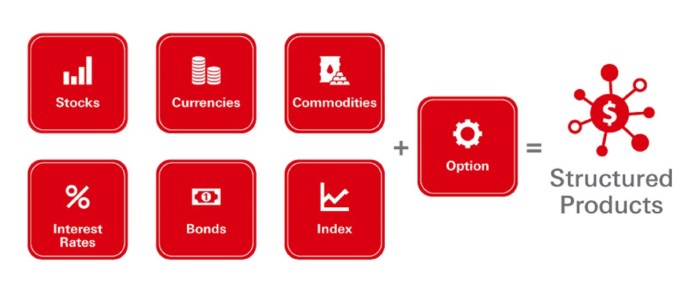Yo, structured financial products are like a whole new level of investing, way different from the usual stuff. Get ready for a deep dive into this topic that’s gonna blow your mind with all the deets and examples.
So, buckle up and let’s explore this fascinating world of structured financial products together.
Definition of Structured Financial Products
Structured financial products are complex investment instruments created by combining various financial assets to offer investors exposure to different underlying assets or market conditions. These products are designed to meet specific investment goals and risk tolerance levels, providing investors with a tailored approach to investing that differs from traditional investment options.
Examples of Structured Financial Products
- Structured Notes: These are debt securities with returns linked to the performance of an underlying asset, such as a stock, bond, or index.
- Certificates of Deposit: These are time deposits offered by banks that combine the features of a traditional CD with an investment component linked to market performance.
- Equity-Linked Notes: These are fixed-income securities with returns linked to the performance of a specific stock or equity index.
Characteristics of Structured Financial Products
- Customization: Structured financial products can be customized to meet the specific needs and risk appetite of investors, offering a tailored investment solution.
- Risk: These products often involve complex pay-off structures and may carry higher levels of risk compared to traditional investments, depending on the underlying assets and market conditions.
- Return Profiles: Structured financial products offer the potential for enhanced returns through exposure to different asset classes or market movements, providing investors with unique opportunities for portfolio diversification.
Types of Structured Financial Products

Structured financial products come in various forms, each serving a specific purpose in the world of finance. Let’s dive into some common types and explore their features, risks, and returns.
Credit-Linked Notes
Credit-linked notes are debt securities with payments linked to the credit performance of an underlying asset, such as a corporate bond or loan. These products allow investors to gain exposure to credit risk without owning the actual asset. The purpose of credit-linked notes is to provide a way for investors to customize their risk exposure based on their risk appetite. These products offer potentially high returns but come with a higher level of risk compared to traditional bonds.
Collateralized Debt Obligations (CDOs)
Collateralized Debt Obligations (CDOs) are structured products that pool together various types of debt, such as mortgages, bonds, or loans, and repackages them into different tranches with varying levels of risk and return. The purpose of CDOs is to create diversified investment opportunities for investors while spreading out the risk. However, these products gained notoriety during the 2008 financial crisis for their role in amplifying the crisis due to their complex structures and lack of transparency.
Mortgage-Backed Securities (MBS)
Mortgage-Backed Securities (MBS) are financial products that represent ownership in a pool of mortgage loans. Investors receive payments based on the interest and principal payments made by borrowers on the underlying mortgages. The purpose of MBS is to provide a way for investors to participate in the real estate market without directly owning physical properties. MBS offer a balance between risk and return, with different types of MBS catering to investors with varying risk profiles.
Structuring Process of Financial Products
When it comes to structuring financial products, the process involves a series of steps that include design, issuance, and distribution. Financial institutions play a crucial role in creating customized structured products to meet the specific needs of investors.
Designing Customized Products
Financial institutions work closely with investors to understand their risk tolerance, investment goals, and desired returns. Based on this information, they design structured products with unique features tailored to meet these specific requirements.
Issuance and Distribution
Once the product is designed, investment banks facilitate the issuance of these structured products in the market. They handle the pricing, underwriting, and marketing of these products to attract potential investors. Financial advisors also play a key role in educating clients about the benefits and risks associated with these structured products.
Risk Management in Structured Financial Products
When it comes to structured financial products, managing risks is crucial for investors to protect their investments. These products are not without risks, and understanding how to mitigate them is essential for success in the market.
Credit Risk, Market Risk, and Liquidity Risk
- Credit Risk: This is the risk that the issuer of the structured product may default on payments, leading to losses for investors. To mitigate this risk, investors can look for products with higher credit ratings or use credit enhancements like guarantees from third parties.
- Market Risk: Market fluctuations can impact the value of structured products, especially those linked to underlying assets like stocks or commodities. Hedging strategies, such as using derivatives, can help investors protect their investments from market volatility.
- Liquidity Risk: Structured products may have limited liquidity, making it difficult for investors to sell them at a fair price. Diversification across different types of structured products can help spread this risk and ensure a more liquid portfolio.
Risk Mitigation Strategies
- Diversification: Spreading investments across different structured products can help reduce overall risk exposure and protect against losses in any single product.
- Hedging: Using derivatives or other financial instruments to offset potential losses in structured products can help investors protect their portfolio from market volatility.
- Credit Enhancements: Seeking products with added security measures, such as guarantees or collateral, can provide an extra layer of protection against credit risk.
Importance of Understanding and Managing Risks
Investors need to have a clear understanding of the risks associated with structured products to make informed decisions and protect their investments. By actively managing risks through strategies like diversification, hedging, and credit enhancements, investors can minimize potential losses and maximize returns in their structured product portfolios.
